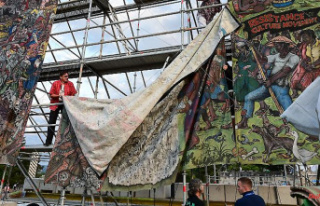The flood of the century on the Ahr is a case for the history books and for the museum. The House of History collects objects to document the event for future generations. The special challenge here: Many pieces are caked with mud and should remain so.
A mud-encrusted doll, a dirty spade, a brown-smeared Pope's portrait: the House of History in Bonn has collected around 400 items related to the flood of the century. "We collect objects that document the catastrophe in its various facets," says collection director Manfred Wichmann. Private individuals and institutions have provided things that testify to the consequences of the floods that devastated entire areas in North Rhine-Westphalia and Rhineland-Palatinate in July 2021.
A sign on a knotted white fabric bag warns: "Flooding object! Very fragile!! Please only touch here (end)". In the bag: a right shoe. Objects like this or the doll, which probably belonged to a child and was washed up in the Ahr Valley in Rhineland-Palatinate, show the emotional side of what happened in a special way: "It is an event that also brought with it many human tragedies", says Wichmann. This is exactly why the museum employees had to be very sensitive when searching for objects.
On the one hand, the inhabitants of the flood areas had experienced great suffering. On the other hand, it was clear that there was not long to get the items in their original condition - including the mud. "Normally, dirt is the biggest enemy in a museum depot. Here it's exactly the opposite: the dirt characterizes the special nature of the objects," says Wichmann. But how do you manage to make the brownish-grey incrustations on the objects so durable that they don't fall off after a certain time? "It's really a big challenge. We've never had to conserve dirt before," says restorer Julia Weispfennig.
On the doll, for example, she applied a kind of fine mist containing a setting agent. "But there is no patent solution." Each object must be viewed individually and - depending on the surface condition - treated differently. Among the things collected are many that show the great solidarity after the flood, such as the work clothes of a helper from Bad Münstereifel or a leaflet that was probably quickly printed out for the "helper shuttle".
According to Wichmann, a tumble dryer with brown dirt sprinklers does not come from a household, but from the Bundesbank: its employees dried wet banknotes in it that came from residents of the flood areas or flooded banks. However, many bills could no longer be saved: This is evidenced by a whole box full of damaged euro bills with an original total value of around 10,000 euros - but now all canceled.
Wichmann explains that the flood objects are now gradually being preserved and then entered in the House of History's online database. An exhibition on the subject of the flood is not planned, at least in the foreseeable future. Individual objects would also be loaned to other museums or integrated into their own exhibitions. A mud-encrusted gas meter from the flood area can currently be seen in the show "Home. A Search" in the House of History.












